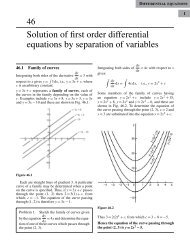vector
You also want an ePaper? Increase the reach of your titles
YUMPU automatically turns print PDFs into web optimized ePapers that Google loves.
Vectors 465<br />
<br />
<br />
Fnds ˆ =<br />
1 1<br />
<br />
0 0<br />
(4 xziˆ ˆj zkˆ<br />
) ( ˆj)<br />
dx dz<br />
ˆn = ˆ, j ds dxdz =<br />
=<br />
1 1<br />
dx dz =<br />
0 0<br />
1 1<br />
<br />
0 0<br />
dxdz<br />
1 1<br />
0 z 0<br />
( x) ( ) = – (1) (1) = – 1<br />
Over the face DEFG, z = 1, dz = 0, ˆn = ˆk , ds = dx dy<br />
<br />
<br />
Fnds ˆ =<br />
=<br />
1 1 2<br />
<br />
0 0<br />
[4 x (1) y ˆj y(1) kˆ]()<br />
kˆ<br />
dx dy<br />
1 1<br />
ydxdy =<br />
0 0<br />
1 1<br />
dx ydy = ( x)<br />
0 0<br />
Over the face OCDG, x = 0, dx = 0, ˆn = – iˆ,<br />
<br />
<br />
1<br />
0<br />
ds = dy dz<br />
Fnds ˆ = 1 1 ˆ 2 ˆ ˆ ˆ<br />
(0 i y j yzk ) ( i ) dydz = 0<br />
0 0<br />
Over the face AOGF, y = 0, dy = 0, ˆn = – ĵ ,<br />
<br />
<br />
Fnds ˆ =<br />
1 1<br />
(4 ˆ) ( ˆ<br />
xzi j)<br />
dxdz = 0<br />
0 0<br />
Over the face ABEF, x = 1, dx = 0, ˆn = î ,<br />
<br />
<br />
Fnds ˆ =<br />
1 1 2<br />
0 0<br />
[(4 zi ˆ y ˆ j yzk ˆ)()]<br />
i ˆ dydz<br />
=<br />
1 dy<br />
1<br />
4<br />
0 0<br />
1 2 1<br />
dy (2 z )<br />
0<br />
0<br />
1<br />
<br />
2<br />
y <br />
<br />
2 <br />
<br />
0<br />
ds = dx dz<br />
ds = dy dz<br />
1<br />
0<br />
= 1 2<br />
1 1<br />
4 zdydz<br />
0 0<br />
= zdz = = 2 dy = 2( y) 2<br />
On adding we see that over the whole surface<br />
Fnds<br />
1 <br />
ˆ = 01 0 0<br />
2<br />
2 = 3 2<br />
From (1) and (2), we have<br />
1. Use Divergence Theorem to evaluate<br />
V<br />
<br />
Fdv<br />
Fnds<br />
<br />
<br />
S<br />
<br />
= <br />
ˆ<br />
EXERCISE 5.15<br />
<br />
2 2 2 2 2<br />
( y z i ˆ z x ˆ j x y 2ˆ k ). ds ,<br />
s<br />
1<br />
0<br />
...(2)<br />
Verified.<br />
where S is the upper part of the sphere x 2 + y 2 + z 2 = 9 above xy- plane. Ans. 243 <br />
8<br />
<br />
<br />
2. Evaluate ( F). ds,<br />
where S is the surface of the paraboloid x 2 + y 2 + z = 4 above the xy-plane and<br />
<br />
S<br />
2 ˆ ˆ<br />
2<br />
F ( x y 4) i 3 xyj (2 xz z ) kˆ<br />
.<br />
Ans. – 4 <br />
<br />
2 2 3 2<br />
3. Evaluate [ xz dy dz ( x y z ) dzdx (2 xy y z) dxdy],<br />
where S is the surface enclosing a<br />
s<br />
region bounded by hemisphere x 2 + y 2 + z 2 = 4 above XY-plane.<br />
4. Verify Divergence Theorem for 2<br />
F x iˆ zj ˆ yzkˆ<br />
, taken over the cube bounded by<br />
x = 0, x = 1, y = 0, y = 1, z = 0, z = 1.<br />
2<br />
5. Evaluate (2 ˆ ˆ ˆ<br />
xyi yz j xz k)<br />
ds <br />
over the surface of the region bounded by<br />
S<br />
x = 0, y = 0, y = 3, z = 0 and x + 2 z = 6 Ans. 351<br />
2










